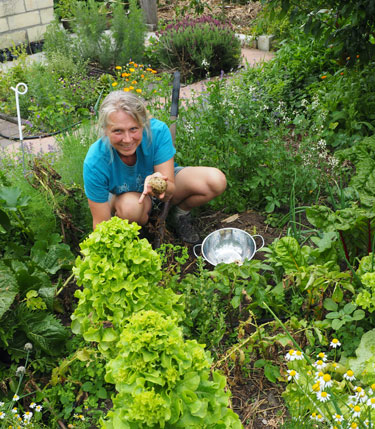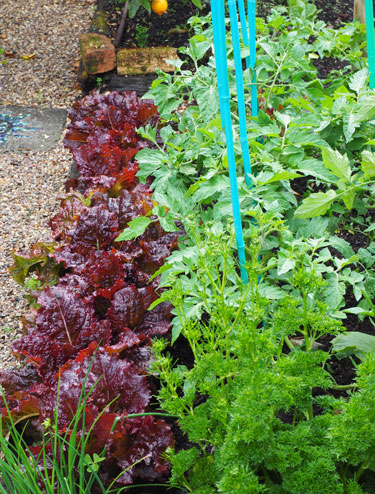Non-stop crops - the art of succession planting
By thinking ahead and engaging in the concept of succession planting, even a small garden can be surprisingly productive over the warm months ahead. Regular planting provides a constant flow of daily goodness from garden to plate right through spring, summer and autumn. Winter too, if you’re blessed with the right climate.
With succession planting, the flow of veges ready for harvest is managed by sowing a fresh batch of seeds or planting another punnet of seedlings at regular intervals, every two or three weeks. One crop is planted as soon as another is harvested. Quick growers like beans and lettuces are planted in the spaces between larger, slower growing plants like brassicas, tomatoes and cucurbits. The fast crops are edibles harvested before the slower crops need the space.
It’s an intensive way of gardening that minimises the time any patch of soil is left bare. This not only means more vegetables can be grown in less space, but also protects the soil. Obviously the more intensively we garden, the more we need to nurture the soil.
There are no set rules with succession planting. Every gardener develops their own special ways of doing things. And every gardener gets better every year as they become acquainted with their own soil and climate.
Succession planting works whether you plant in rows, or more informally. There is a lot to be said for the soldier straight rows our grandfathers are famous for. Accessibility and allowing enough space for sunshine and air flow are still important, but these days fewer of us have the luxury of a large back garden. Concepts like the ‘square metre’ garden, where crops are planted in irregular shaped groupings make it easy to fit more veges in, and to plug harvest gaps as the season progresses. As the proponents of ‘bio-intensive gardening’ point out, the less space we use to grow the food, the more space is left over for wilderness, biodiversity and play.
There is wisdom in growing only what your own household wants to eat. However, if growing loads of pretty lettuces is where you get your thrills, or you happen to be the local carrot or tomato growing pro, there is enormous satisfaction in sharing, while introducing others to the superior taste of home grown. Plant what you love to eat - or what you love to grow.
20 space-saving ways to boost backyard bounty
1 |
Neither feast nor famine is the aim with succession planting. Rather than sowing an entire packet of seed at once, sow a few seeds every few weeks, especially if you want to achieve a continuous supply of quick crops like beans, beets and lettuces. |
| 2 | Use salad greens as ‘space savers’ to to avoid the temptation to plant the likes of brassicas and tomatoes too close together. Spacing larger growers generously then filling the gaps with salad greens will keep the soil covered and free of weeds until the slower crops need more breathing space later in the session. Similarly, an early crop of beans or salad greens can act as a space saver for the likes of sweetcorn or runner beans which can’t be planted until the soil warms up in early summer. |
| 3 | Have seedlings on standby ready to fill gaps as you harvest. Pick up a pack of seedlings from the garden centre every couple of weeks when you go out for coffee. Mixed punnets of salad greens are available for those who don’t want too many of each variety. Alternatively, raise your own seedlings in seed trays, little pots or recycled six-packs. Most vege plants transplant easily. The exceptions are carrots, parsnips and plants like coriander which have deep tap roots. |
| 4 | Plug gaps without delay before the weeds steal the space. Each time you pull out a mature plant pop a lettuce seedling or sow a few radish or rocket seeds in its place. Speedy salad leaves reach full size about 20 days after planting, but they can be picked small too. Plant lots of variety, including, mustards, mizuna, kale and rocket for different colours, tastes and textures and salads that are never boring. |
| 5 | Make use of microclimates created by taller crops. Plant crops like lettuce, basil and spinach don’t like hot summer sun. Make the most of shadier spots around taller crops like tomatoes runner beans, and sweet corn to grow these tender plants over summer, and keep the soil constantly moist. |
| 6 | Plant in layers to make the most of space. Zucchini planted around sweetcorn plants acts as a weed suppressing groundcover. |
| 7 | Replenish the soil with compost each time you replant seedlings. Use a hand tool to aerate the soil and mix in some fresh compost each time you replant leafy greens. Use pea straw or other mulch to protect any bare soil from moisture-robbing summer weather and to keep the soil moist and friable for easy planting. |
| 8 | Plant quick crops in relay. A replacement batch of carrot seeds or salad seedlings can go in the ground a few weeks before the previous batch is harvested. The almost-ready crop will be harvested before the new crop needs the space. |
| 9 | Choose a seed variety that's right for the season. Quick growing spinach is great for succession plantings but it’s no heat lover, often bolting to seed in summer. In spring, plant a heat resistant variety, switching to a winter variety in autumn. Peas also have distinct winter and summer varieties, while cos is one of the lettuces known for its heat tolerance. |
| 10 | Look for vegetable varieties that are quick to mature. Some lettuces grow even faster than others. Carrots are not the speediest of crops but some are ready sooner than others. Look at the maturity date on the seed packet or plant label. |
| 11 | Pick early. There is no need to wait for salad greens to reach full maturity before you pick leaves for a salad or even harvest the whole plant, freeing up space for its neighbours to grow. Carrots can be eaten at any stage of growth before they become too old and woody. Beans and zucchini picked small are the tastiest of all and picking them encourages the plant to produce more. |
| 12 | Grow radishes. They are super speedy, very easy to grow, and ready to eat within a month of sowing. Sow a few seeds every week or two and enjoy their fresh peppery zing every day. They’re nice roasted too. Seeds are big enough to handle so they can be spaced without the need for thinning. Harvest and eat radishes before they become woody and pungent. There is an interesting range to choose from, including the lovely white Daikon radish. |
| 13 | Grow dwarf beans all summer long. Ready to harvest about 60 days after sowing, dwarf (aka French or bush) beans are ideally sown every three or four weeks for a continuous supply. They produce a hefty crop for their compact size and great gap fillers in late summer, sown directly into the soil immediately after a crop such as garlic is harvested. |
| 14 | Sow a batch of beetroot seeds every few weeks for a continuous supply. While other root crops need to be sown in situ, beetroot transplants well. This versatile and highly nutritious root vege can be eaten cooked or raw. You can also eat the young leaves, cooked or raw. It’s ready for harvest 8–10 weeks from sowing. |
| 15 | Sow snow peas early. Like all peas, they hate heat, and need cooler soil for germination, but these quick maturing, high protein pods are great for salads and snacks. Make spring sowings direct into rich moist soil every few weeks until November, then again in autumn. |
| 16 | Plant cucumbers more than once. These highly productive vines eventually run out of oomph so planting a few seeds every three to four weeks, two or three times over the season avoid gluts while providing a summer long supply. Fruit left on the vine past maturity become bitter. Cucumber plants happily over the ground but they can also be grown on a trellis or teepee to allow more space for planting smaller crops underneath. TIP: Cucumber roots can be tetchy about being transplanted. Grow seedlings in single pots and be gentle with the roots at transplanting planting time, or direct sow into warm soil. Plant two or three seeds in a little mound of soil (for extra warmth) and then remove the weakest two seedlings. |
| 17 | Know your tomatoes. Varieties (mainly tall) that keep on growing and producing fruit until the first frost are called ‘indeterminate’ tomatoes. Some mature earlier than others so planting a few different varieties can give a longer harvest season. Determinate varieties (mainly low growers) produce their crop in one flush, providing space for a late summer planting crop (e.g. brassicas or beans). Later planted tomatoes tomatoes will continue to bear fruit until the first frost, but never plant potatoes where a crop of tomatoes has been, or vice versa, as they suffer from the same pests diseases. |
| 18 | Plant edible flowers. Calendulas and marigolds make colourful great gap fillers to brighten the scene while attracting pollinators and other beneficial insects. Plant marigolds where pumpkins grew last year to repel soil nematodes. |
| 19 | Keeping a record of planting and harvesting times is a great way to get acquainted with what works best in your climate. Record spring and summer successes for future planning. |
| 20 | Little and often is the best way to garden intensively in a small space. A Labour weekend planting blitz needs regular follow ups to keep on top of watering, weeding and replanting. Plan, for example, to plant something at least every second weekend, whether it’s popping in punnet of salad greens or direct sowing a handful of radish seeds. |
26-Sep-2021

Spring in Anne & Jase's garden

2. Use salad greens as space savers

3. Have seedlings on standby ready to fill gaps

6. Plant in layers to make the most of space

12. Grow radishes

14. Sow a batch of beetroot seeds every few weeks

15. Sow snow peas early

16. Plant cucumbers more than once

17. Know your tomatoes

18. Plant edible flowers


